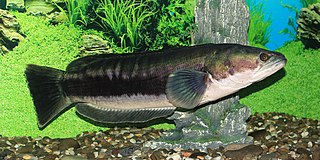
Channa is a genus of predatory fish in the family Channidae, commonly known as snakehead, native to freshwater habitats in Asia. This genus contains about 50 scientifically described species. The genus has a wide natural distribution extending from Iraq in the west, to Indonesia and China in the east, and parts of Siberia in the Far East. A particularly high richness of species exists in Myanmar (Burma) and northeastern India, and many Channa species live nowhere else. In contrast, a few widespread species have been introduced to several regions outside their natural range where they often become invasive. The large and medium-sized Channa species are among the most common staple food fish in several Asian countries and they are extensively cultured. Apart from their importance as a food fish, snakeheads are consumed in some regions as a traditional medicine for wound healing and reducing post-operative pain and discomfort, and collected for the international aquarium pet trade.
The limp eelpout, Melanostigma gelatinosum, is an eelpout, of the genus Melanostigma, found in all oceans at depths of between 50 and 2,500 m. Their length is between 15 and 30 cm.
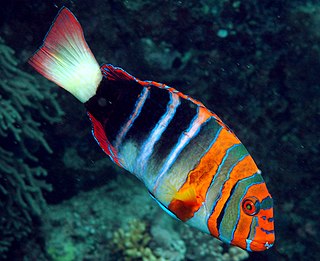
Choerodon is a genus of wrasses native to the Indian Ocean and the western Pacific Ocean. They are commonly referred to as tuskfish, because most species have sharp tusk-like teeth.
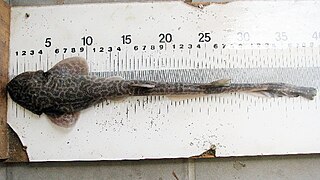
Holohalaelurus is a genus of catshark in the family Scyliorhinidae, commonly known as Izak catsharks or hallelujah sharks.
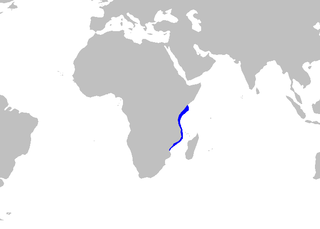
The crying Izak is a very rare catshark of the family Scyliorhinidae. It is found in the western Indian Ocean off Mozambique and Tanzania, at depths of between 600 and 660 m. It can grow up to 38 cm in length.

The orange-bellied flowerpecker is a species of bird in the family Dicaeidae. It is found in Bangladesh, Brunei, India, Indonesia, Malaysia, Myanmar, the Philippines, Singapore, and Thailand.

Callochromis melanostigma is a species of cichlid endemic to Lake Tanganyika where it prefers sandy bottoms with nearby rocks. This fish grows to a length of 15 centimetres (5.9 in) TL. It is also found in the aquarium trade.
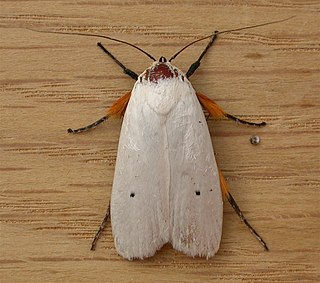
The fruit tree borer is a moth of the family Xyloryctidae. It is native to Australia.
Catapsephis is a genus of moths of the family Crambidae.

Anatrachyntis is a genus of moths in the family Cosmopterigidae. Some authors include it in Pyroderces.

The honeycomb grouper, also known as black-spotted rock-cod, common birdwire rockcod, dwarf spotted rockcod, dwarf-spotted grouper, honeycomb cod, wire-netted reefcod or wire-netting cod, is a species of marine ray-finned fish, a grouper from the subfamily Epinephelinae which is part of the family Serranidae, which also includes the anthias and sea basses. It has a wide Indo-Pacific distribution where it is found in coastal and offshore reefs in shallow waters.

Mulayit Wildlife Sanctuary is a protected area in Myanmar's Kayin State, covering 138.56 km2 (53.50 sq mi). It ranges in elevation from 80 to 2,010 m and encompasses grassland, evergreen forest and mixed deciduous forest in Kyain Seikgyi Township. It was gazetted in 1936. It is located on the western slopes of the Dawna Range and was established with the support of Buddhist monks.
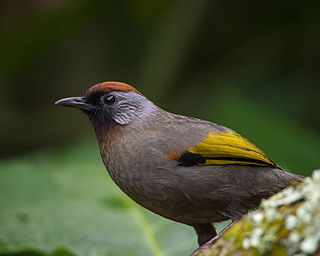
The silver-eared laughingthrush is a species of bird in the family Leiothrichidae. It is found in southern Yunnan, Laos, Myanmar, Thailand and Vietnam. It was formerly considered a subspecies of the chestnut-crowned laughingthrush, G. erythrocephalus.

Sphenella is a genus of the family Tephritidae, better known as fruit flies.

Pseudosynanceia melanostigma, the blackfin stonefish, is a species of stonefish native to the western Indian Ocean where it occurs in areas with muddy bottoms. This species grows to a length of 13 centimetres (5.1 in) SL. This species is the only known member of its genus.
Spilarctia melanostigma is a moth in the family Erebidae. It was described by Nikolay Grigoryevich Erschoff in 1872. It is found in Uzbekistan, Kyrgyzstan, Hissar, Pamirs, Afghanistan, Pakistan and from the Himalayas to Sikkim and Assam.
Maroga is a genus of moths of the family Xyloryctidae.

Puntius melanostigma is a species of ray-finned fish in the genus Puntius from India.
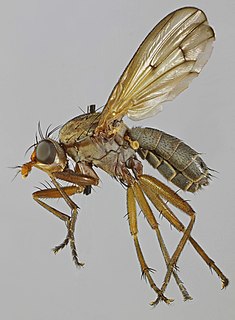
Tetanocera is a genus of marsh flies, insects in the family Sciomyzidae. There are at least 50 described species in Tetanocera.
Tetanocera melanostigma is a species of marsh fly in the family Sciomyzidae.














